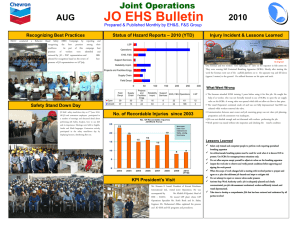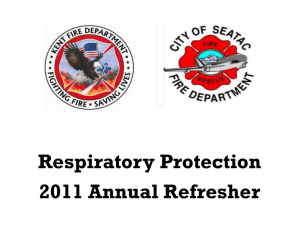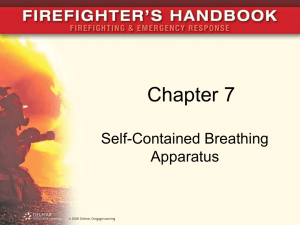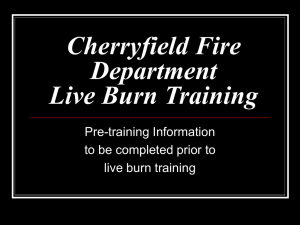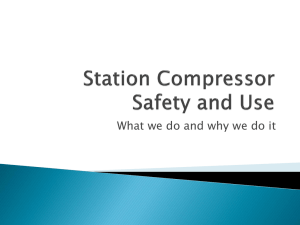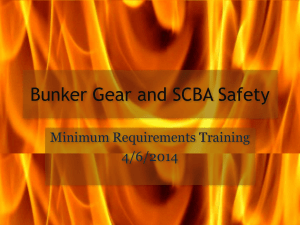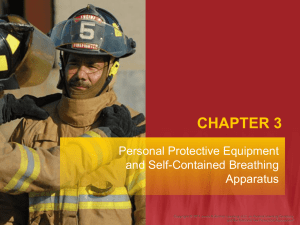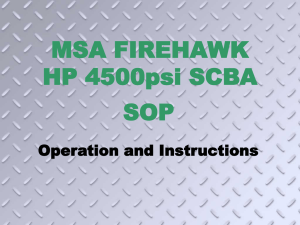CVFD Training – SCBA B27.1
advertisement
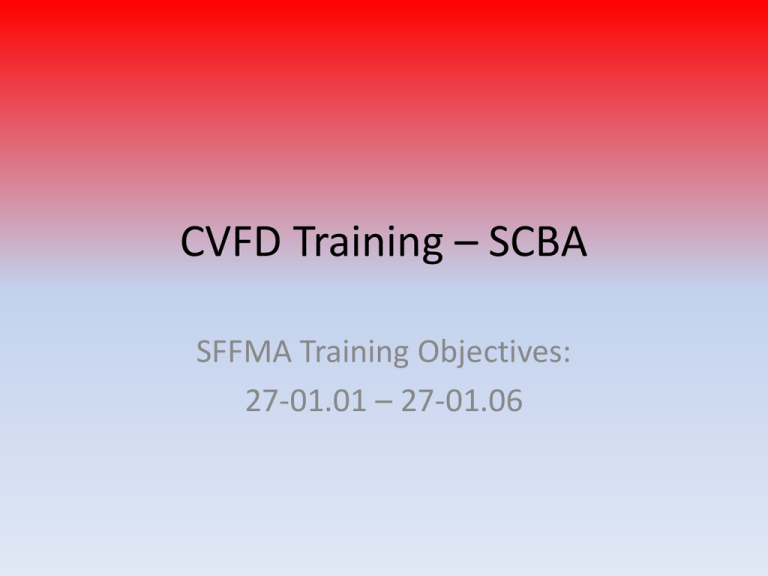
CVFD Training – SCBA SFFMA Training Objectives: 27-01.01 – 27-01.06 Objectives (1 of 2) • List two conditions requiring respiratory protection. • List and explain the effects of oxygen deficiency and toxic gases on the human body. • List one legal requirement for use of SCBA. • List two types of SCBA. • List four components of the SCBA used by the authority having jurisdiction. 7.2 Objectives (2 of 2) • Demonstrate two different SCBA donning procedures. • Demonstrate routine inspection of SCBA. • Demonstrate after-use maintenance and servicing. • Demonstrate the servicing of an SCBA cylinder with the air-filling system. 7.3 Introduction (1 of 3) • SCBA an important item of PPE. • SCBA allows firefighters to work in oxygen deficient atmospheres. • Human body very vulnerable to oxygen deficient atmosphere. • Respiratory protection policy must exist. • SCBA required in an IDLH area. Click Here to View Video: SCBA Functions 7.4 Introduction (2 of 3) • Many changes in SCBAs since the 1970s – Decrease in weight – Must be positive pressure – Improved design – SCBA maintenance programs – PASS devices – Better training programs – Increased regulations 7.5 Introduction (3 of 3) • Improvements – Technology – Regulations – Mandates • SCBA improvements are only as effective as the training and proficiency firefighters develop in using SCBA. 7.6 Conditions Requiring Respiratory Protection • • • • Oxygen deficiency High temperatures Smoke Unburned products of combustion • Toxic environment 7.7 Oxygen-Deficient Environments • Humans and fire both require oxygen to survive. • Oxygen deficiency is detrimental to the human body. Click Here to View Video: Proper Use of SCBA/ Effects of Smoke and Fire 7.8 Click Here to View Video: SCBA Standards, Types and Limitations Elevated Temperatures and Smoke • Inhalation of heated gases can cause fluid to build up in the lungs and create longterm, irreversible damage. • Combustion by-products are very irritating to the body. • High temperatures can also cause severe burns to the respiratory system. 7.9 PPE for Oxygen-Deficient Environment 7.10 Effects of Toxic Gases and Environments (1 of 2) • Toxic gases are produced by combustion. – These gases affect various body systems. • Hazardous materials can increase the risk to firefighters. • CO is one of the most lethal gases produced by fire. – CO attaches to blood 218 times easier than O2. 7.11 Effects of Toxic Gases and Environments (2 of 2) • CO prevents distribution of O2 in the body, causing hypoxia. • Without SCBA, a firefighter will not survive. • Repeated exposure to toxins has long-term effects. 7.12 Legal Requirements for SCBA • OSHA - Respiratory Protection Standard Title 29 CFR 1910.134 • 29 CFR 1910.134 standard for all entries into IDLH atmospheres • NFPA standards (1500, 1404, 1981) • NIOSH 42 CFR Part 84 7.13 Organizations Concerned with SCBA Design and Use Organizations Concerned with SCBA Design and Use 7.14 ORGANIZATION STANDARD APPLICATION National Institute for Occupational Safety & Health (NIOSH) 42 CFR Part 84 Requirements for design, testing, certifying SCBA Occupational Safety & Health Administration (OSHA) 29 CFR 1910.134 Respiratory protection programs for SCBA use Occupational Safety & Health Administration 29 CFR 1910.156 Fire Brigade Standard, references 1910.134 National Fire Protection Association NFPA 1404 Standard for Fire Department SCBA Program National Fire Protection Association NFPA 1500 Standard on Fire Department Occupational Safety & Health Program National Fire Protection Association NFPA 1981 Standard on Open-Circuit SCBA for the Fire Service Limitations of SCBA (1 of 2) • SCBA design and size – Increases weight and girth – Decreases mobility – Requires good physical conditioning – Must be aware of how long air will last – Limits visibility – Voice muffled and hard to understand 7.15 Limitations of SCBA (2 of 2) • Limitations of SCBA user – Factors such as facial hair or weight loss can alter mask effectiveness. – Lack of confidence can lead to anxiety. – Training/experience will improve confidence and ability. – Increased physical stress causes anxiety. – Emotional state may affect respiratory rate and air consumption. 7.16 Constant Training Is Essential Click Here to View Video: SCBA in Emergency Situations 7.17 Physically Demanding Tasks 7.18 Types of SCBA • Two types of SCBA in use – Open-circuit SCBA – Closed-circuit SCBA • Both built according to NIOSH and NFPA standards 7.19 Open-Circuit SCBA (1 of 2) 7.20 Open-Circuit SCBA (2 of 2) • SCBA has four assembly components. – Backpack and harness – Cylinder – Regulator – Face piece assembly 7.21 SCBA Harness Assembly 7.22 Open-Circuit SCBA — Cylinders (1 of 2) • SCBA cylinders vary in material and type. • USDOT regulates compressed gas cylinders. • Quality of the compressed breathing gas has a direct effect on the performance of the SCBA. 7.23 Open-Circuit SCBA — Cylinders (2 of 2) SCBA Air Cylinder Capacities 7.24 RATED DURATION (MINUTES) MATERIAL CYLINDER PRESSURE (PSI) CAPACITY COMPRESSED AIR (FT3) 30 Aluminum or Composite 2,216 44 30 Aluminum or Composite 4,500 44 45 Carbon Fiber 3,000 65 45 Aluminum or Composite 2,216 65 45 Aluminum or Composite 4,500 65 60 Aluminum or Composite 4,500 88 SCBA Regulator (1 of 2) • Regulator is attached to the face piece or waist strap. • Regulator has a pressure gauge. • Regulator is activated by user’s breathing action. 7.25 SCBA Regulator (2 of 2) • The regulator maintains constant positive pressure airflow to the face piece. • Units have low air supply warning alarm. • NFPA 1981 requires two types of alarms. 7.26 SCBA Face Pieces • Annual face piece fit test is required. • Exhalation valve keeps toxic gases out. 7.27 Closed-Circuit SCBA • Not used for regular firefighting operations • Commonly used for hazmat operations and below-grade rescues • Contains cylinder, filter system, regulator, and valves 7.28 Open-Circuit Supplied Air Respirator (SAR) • Air supply cylinder is remote from user. • It provides user with long- duration air supply. • It is used for hazmat operations and confined space rescues. 7.29 Donning and Doffing SCBA (1 of 2) • Perform safety check first. • Use one of two methods. – Over the head method – Coat method • SCBA is also mounted in seats. • Never stand to don while apparatus is moving. • After securing SCBA, don face piece. 7.30 Click Here to View Video: SCBA Testing and Service/ Donning SCBA Donning and Doffing SCBA (2 of 2) • The proper donning of a face piece is essential. • After exiting hazardous area, remove SCBA. Remove face piece while waiting for assignment. • Local protocol may require rehab after assignment. 7.31 Over the Head Method 7.32 Coat Method 7.33 Seat-Mounted SCBA 7.34 SCBA Operation and Emergency Procedures • Firefighters must be proficient in: – Safe use of SCBA – Donning and doffing procedures – Individual limitations – Limitations of SCBA 7.35 Safe Use of SCBA (1 of 2) • Firefighters must be physically fit for respirator use. • Accountability system should be in place. • Must work in teams of two at a minimum. • OSHA “two in/two out” regulation. • PASS device must be activated. 7.36 Safe Use of SCBA (2 of 2) • • • • SCBA operations should include rehab time. Stay hydrated during rehab. Air consumption will vary for all. Never remove the face piece in a contaminated environment. • Low air alarm on one team member means the whole team exits. 7.37 PASS Devices 7.38 Operating in a Hostile Environment (1 of 2) • Always check in/out with accountability officer. • Always remain low. • Check the environment. • Never remove a face piece. • Be aware of your location at all times. 7.39 Operating in a Hostile Environment (2 of 2) • Ventilate as you advance. • Check outside openings. • Maintain contact with team members. • Never enter a hostile environment alone. 7.40 Restricted Openings • Never remove face piece! • Loosen straps and rotate SCBA under arm. • Remove harness and hold SCBA as a last resort. • Do not lose contact with SCBA. • Maintain control of unit. • Practice procedures regularly. 7.41 SCBA Use in Restricted Openings 7.42 Emergency Procedures with SCBA • • • • • Remain calm. Immediately exit hazardous area. Activate PASS device. Announce your emergency over the radio. If regulator or face piece fails, use bypass valve. • Buddy breathing is only a last resort. 7.43 Inspection and Maintenance of SCBA • Have SCBA ready to go at all times. • Routinely inspect SCBA. – Remove unit and check it after each use. – Monthly operational check should be done. • Service less than full cylinder. 7.44 Servicing SCBA Cylinders • Test and certify air source. • Cylinders must have current hydrostatic test date. • Fill stations must have fragmentation containment devices. • Always follow manufacturer’s recommendations. • Remember, fill rates will vary. 7.45 Fragmentation Containment Device 7.46 Summary • SCBA is one of the most important PPE items. • Both SCBA and the user have limitations. • Firefighters must be familiar and comfortable with use of SCBA. • Firefighters need to be proficient in the proper and rapid donning of SCBA • Routine inspections and maintenance are important. 7.47
